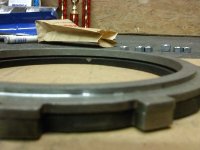Forward Clutch Pack:
- This pack is located right behind the input shaft hub.
- Stock 47re has (4) frictions
- Stock 48re has (4) frictions with a different spline count so if you buy a 48re rebuild kit just remember to buy extra clutches for this pack that don't have the 93 center splines like the 48re clutches.
- This pack is applied in all forward gears and it's not a shifting pack so it's not subject to as much wear as the other packs.
- This pack is released when the transmission shifts into reverse.
- This pack is the most difficult one to upgrade since space is very limited.
I upgraded this pack from (4) frictions and steels to (5) frictions and steels for 25% increase in clutch capacity by purchasing a used forward clutch pressure plate and using it as a stepped reaction plate. This drums snap ring groove is machined a little tighter than the direct drum and it's nearly impossible to install the snap ring without grinding a little bit of the inner corner so the plate has a wider flat stepped portion for the snap ring.

The arrows point to the small corner than needs to be ground just a little to gain clearance for the wide snap ring. I just used a 4-1/2" grinder with a 1/8" thick metal cutting wheel and slowly made an approximate 0.030" deep cut and worked my way around the entire pressure plate. It is possible to install the snap ring without grinding the plate but makes the clutch pack a little tight which would cause it to drag a little in reverse, not a good idea for a daily driver that uses reverse regularly but running an unground/unmodified pressure plate hasn't been a problem for my drag race truck.
With increased line pressure, this pack seems to do fine with the stock (4) clutch count in 47re and 48re on diesel applications up to about 500 HP rear wheel horsepower, after that it's probably a good idea to upgrade this pack.




